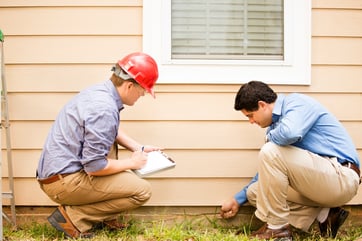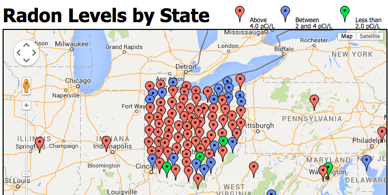Radon Fluctuation Inside Homes
A large percentage of Ohio homes have high levels of Radon Gas. Since you cannot detect radon by taste, smell, or sight, it is necessary to have your home tested by a licensed radon testing specialist.
There is a lot of misinformation about radon. Read our blog post "Common Misconceptions of Radon Gas" here!
 Table of Contents
Table of Contents
- Short-Term Testing
- Long Term Testing
- Why do Radon Gas Levels Fluctuate?
- Weather
- Schedule a Discounted Radon Test
There are two different types of radon testing that can be done:
Short-Term Testing
Short term radon testing is any amount of time less than 54 hours. Some companies will try to save time by only leaving a test in your home for 24 hours. By doing this, you may either end up with results stating your radon gas level is higher or lower than what it is. The shorter the test, the wider the range of test results.
Long Term Testing
A long-term radon test is considered any amount of time 54 hours or more. It is crucial to have a radon test performed for at least 54 hours to obtain an accurate reading. Radon Gas Levels may fluctuate from day-to-day.
Why Do Radon Gas Levels Fluctuate?
There is a broad range of reasons as to why radon gas may fluctuate in a home in just a single day.
Home Air Exhaust Devices
- Clothes Dryer
- Open Wood Fireplace
- Central Vacuum Cleaner
- Bathroom Fan
- Furnace
- Space Heater
- Water Heater
All of these devices cause more radon to be sucked out of the soil and into the air of the home.
Weather
Weather is another factor that contributes to the fluctuation of radon gas levels in a given home.
Rain Storms: Rain storms can block soil pathways and either raise or reduce indoor radon concentration levels. Typically radon levels are higher during torrential rains.
Strong winds: Depending on how the wind hits a home it will either create a more positive indoor pressure that pushes the radon out or a negative indoor pressure which sucks more radon into the home.
Winter: Radon levels are typically higher during the winter months because the heating system is pulling air up and out of the home. When the ground is frozen, it creates a resistance for the soil which is how radon enters the home.
 Radon Gas carries risk, even at or below the recommended action level. The risk of Lung Cancer increases exponentially with higher long-term average radon levels. Professional installation of a Radon Removal system draws radon gas from beneath the foundation of the home to be directly vented outside without having a chance to re-enter. According to the EPA, Radon Removal can eliminate up to 99 percent of radon from the home.
Radon Gas carries risk, even at or below the recommended action level. The risk of Lung Cancer increases exponentially with higher long-term average radon levels. Professional installation of a Radon Removal system draws radon gas from beneath the foundation of the home to be directly vented outside without having a chance to re-enter. According to the EPA, Radon Removal can eliminate up to 99 percent of radon from the home.
Radon Mitigation devices, called soil suction radon reduction systems, should always be installed and supervised by a trained Licensed Radon Mitigation Specialist or Radon Remediation Service Provider.
Radon Eliminator has a team of licensed radon testing professionals who will come to your home and set up a test in your basement for 48 hours to determine an accurate radon gas reading in your home.
Click On the Link Below for a Discounted Radon Test!





